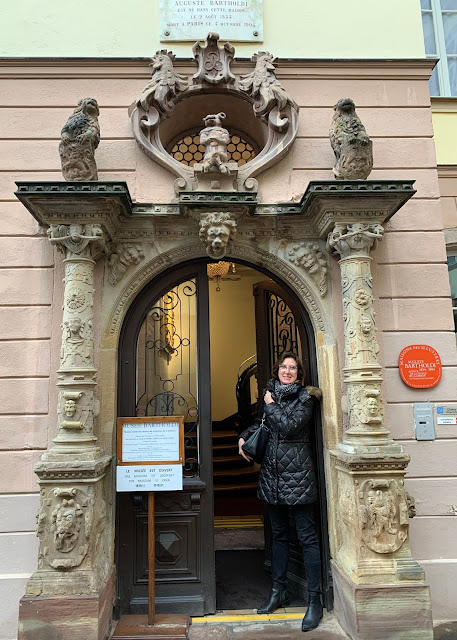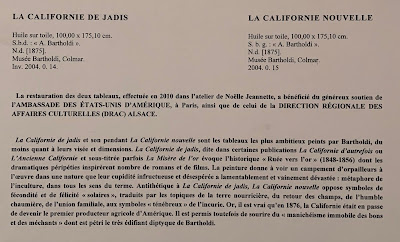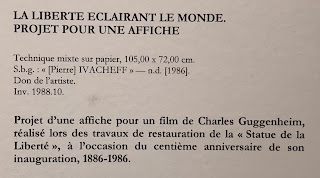Our visit to Colmar continues.
Colmar is home to another wonderful museum, the Musée Bartholdi, founded in 1922.
Colmar is home to another wonderful museum, the Musée Bartholdi, founded in 1922.
The museum is the birthplace and former home of Colmar's favorite son Frédéric Auguste Bartholdi (1834-1904). Even if the name is not familiar, you will recognize his greatest work later in this post.
Bartholdi was born into a wealthy family that lived in a very large home in the center of Colmar. Because of his family's wealth, Bartholdi was well educated and socially adept and was able to pursue a career in the fine arts, primarily sculpture but also painting.
The museum occupies much of the house and has a large collection of Bartholdi's works and artifacts from his life, including complete replicas of rooms in his Paris apartment.
During our tour of the museum, we learned that Bartholdi was not only a talented sculptor and painter, but also a skilled promoter. He was a genius at mass marketing (like his friend Gustave Eiffel) and at befriending the wealthy and powerful to induce them to support his monumental sculptures in Europe and across the ocean.
Below is a replica of the artist's dining room in his Paris apartment. If you look closely, you will see something odd;y interesting.
Bartholdi was a skilled painter, in addition to being a talented sculptor. During a long trip around the United States, he painted many scenes, including landscapes depicting the West.
 |
| La Californie Nouvelle |
Bartholdi was a gifted sculptor from a young age. Below is a bronze created when he was 19 years old.

Below is another sculpture from Bartholdi's youth. It is based on the fairy tale of the Seven Swabians, who fled in terror when the ferocious beast they were hunting appeared suddenly before them. The beast was merely a rabbit.
Bartholdi moved to Paris and studied under Dutch artist Ary Scheffer. Bartholdi later honored his mentor with a bronze likeness.
Below is a painting by Scheffer in the Musée Bartholdi.
Bartholdi appears have to focused his work on majestic figures from myth and history. Here are some examples.
Jean-Claude especially liked how Bartholdi fixed Columbus' gaze across the ocean.
George Washington and the Lafayette were also subjects of Bartholdi's works.
You might remember the Martin Schongauer statue from yesterday's post. Bartholdi created it and four other scultpures to honor the Colmar artist.
Below is a small bronze model for the large stone statue.
Below is a model of one of the four smaller statues placed around the larger Schongauer statue. The small statue below actually depicts Bartholdi sculpting a work of art.
The sculpture below is actually a political statement by Bartholdi. It depicts a typical Alsatian girl holding a bouquet of blue, white and red flowers. The sweet, sad-faced girl represents Bartholdi's beloved region, Alsace, annexed by the German Empire following the 1870 war, while the flowers represent the French flag.
Bartholdi also sculpted famous figures from Colmar's history, including Lazarus Schwendi (1522-1593) and Colmar native General Jean Rapp (1771-1821), one of Napoleon's generals. Both statues were removed in 1940 following Germany's invasion and re-annexation of Alsace. The statues were restored following the Liberation.
One of Bartholdi's monumental statues is the stone sculpture known as the Lion of Belfort. Belfort is a fortress near Colmar. The lion represents French resistance during the War of 1870. The statue is made from carved stone blocks that resemble a sitting lion. The lion is large, measuring 36 feet high and 72 feet long.
Below is a model of the Lion of Belfort.
Auguste Bartholdi is best known for another monumental sculpture. Do you know what it is? If not, the following questions might help you identify his greatest work.
Below is a model of a tall sculpture that Bartholdi proposed for placement near the Sue Canal. Bartholdi's proposal was rejected. However, the model may have served as the inspiration for what famous statue?
The answer appears below in the portrait of Bartholdi.
The museum has a large collection of artifacts related to La Liberté éclairant le monde ("Liberty enlightening the World"), or the Statue of Liberty. The artifacts include paintings, photgraphs and posters. Here is a sampling.
The museum has a replica of the statue's left ear. If you look closely, you will notice an uncanny resemblance to Marie-Chantal's left ear. Very strange.
We hope you enjoyed touring the Musée Bartholdi.













































































No comments:
Post a Comment